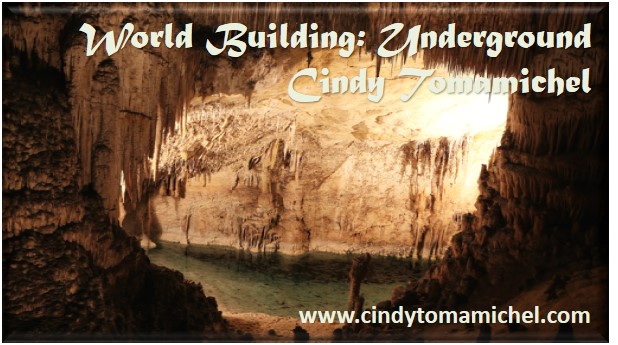Underground environments are both common work places for some, a place to explore, or a fragile ecosystem that can kill a human. A perfect place to set a story!
In this category I include mining, natural cave systems and geysers. All are quite unnatural places to live and explore. Yet humans and creatures can often adapt.

Mines
Old mining areas can be a maze of fall areas, open mined out zones, gas pockets, stale air zones, in terms of structure. After a mine closes, if the groundwater is not still being pumped out, then the mine may well slowly fill, or at least develop areas of water, which will be contaminated with residues of whatever metal was extracted. This will in a surprisingly short period of time become quite acidic, and a source of contamination that is almost impossible to manage. An example of mines and the dangers of collapse and water is in the Poldark series by Winston Graham.
Caves
Natural cave systems can be quite extensive, housing colonies of all sorts of strange and wonderful creatures. Bats are one such, but there are entire ecosystems involving insects, snakes and bacteria that thrive in the ammonia rich atmosphere from the accumulated bat poop. There are also blind fish that generations ago had eyes, yet without the need for them in the dark, slowly lost them. What would happen to humans in this situation? One author (name forgotten alas) speculated two races of people, one with echo location, the other heat sensing abilities.
Caves have also served us well as shelters, as the prehistoric cave art testifies. But hiding from people, escaping pursuit, smuggling and hiding treasure have all been tucked away in caves. Enid Blyton had a fascination with cave systems, often the Famous Five explored secret tunnels, hidden passages and the like. Jean Auel’s Neanderthals could not rest until they had found another cave to call home.
Catacombs
Catacombs are a mix of mining and caves. Often starting out as a mine for limestone for instance, they were extended and used for storing the dead. Catacombs exist in many places in the world such as Rome and Paris. They are even home to some specific phosphorescent bacteria. I had my Roman soldier Trajan in Druid’s Portal slightly claustrophobic as a result of exploring catacombs in Rome as a boy. But as places for storing the dead, and a haven for rats, poor air, and stagnant water, they have formed the basis for many movies and books such as Indiana Jones. A combination of horror and history.
Geysers and hot springs
Geysers are interesting – the chemistry is often highly alkaline, boiling hot and mineral rich. Despite this, many different bacteria thrive, some being used now in manufacturing plastics and antibiotics. Hot springs are a somewhat more gentle version, with hot mineral rich pools being a welcome feature in cold landscapes. There are also geysers of cold materials on other planets, and I refer those interested to https://en.wikipedia.org/wiki/Geyser as a starting point.
But how can these be worked into a story?
For historical fiction, it can be a contemporary use – the difference in working conditions in mines and social structure can be explored. Mark Twain made excellent use of caves when Tom Sawyer, Becky and Injun Joe were trapped there. Horror, love, heroism and danger all showed as the characters did what they could to survive. Or go back into old workings like Indiana Jones or Andy McDermott’s series of archaeological thrillers. Or take a trip to the Earths core in Journey to the Centre of the Earth, or Pellucidar by Edgar Rice Burroughs.
Fantasy can really go to town with underground environments. Readers are unlikely to forget the foreshadowing horror of the fellowship of the ring going into the mines of Moria, and the wakening of the creatures from the innocent dropping of a pebble down an old well. Dwarves are traditional mining races, but many other also – goblins, dragons and races of debased humans or troglodytes are common in older action books such as RE Howard.
Science fiction can also explore caverns on ancient planets filled with giant crystals, faceless serpents, frozen lakes of exotic chemicals, mining operations, and ancient civilisations. For instance, Blish in ‘Welcome to Mars’ and Heinlein both had martians as underground dwellers. Jeanette O’Hagan has a YA fantasy series based underground.
So venturing underground can be an exciting – or fatal trip. Full of wonder, danger and the unknown. Isn’t that what every reader wants?
Enjoy this blog? Have a think about signing up via my website or catch them as they fly around the ether on twitter or facebook. They will stay where they are pinned on pinterest.
For those that have not read Druid’s Portal yet, here is a link to the first chapter of DruidsPortal and to the second in the series Druid’s Portal: The Second Journey, and you can read a preview here.
Scifi more your thing? Try my short stories in the anthologies Quantum Soul and Tales from Alternate Earths 2.
If you are keen to chat with other scifi peeps, then check out the Knights of the Scifi Roundtable facebook group and subscribe to their newsletter https://mailchi.mp/29fb30bca8e4/update-subscription
Short stories and poetry? Try the Rhetoric Askew anthologies: Mixed genre, Adventure or Romance
Tired from all that thinking? Try a 5 Minute Vacation! 5 Minute Vacation
I also have a newsletter for Multi Genre Readers, with a bunch of other talented authors contributing articles. Sign up here.
And my own author newsletter, for book news, odd facts, recipes and random freebies. Sign up here.

